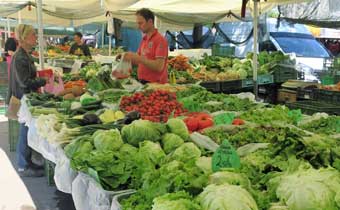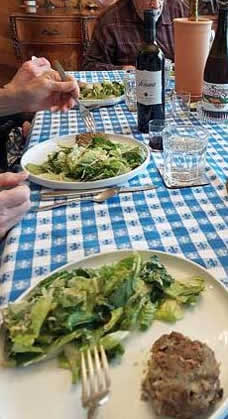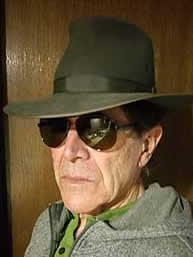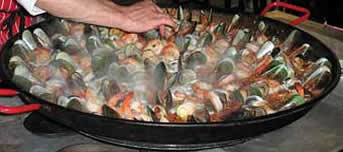| |
My earliest memories of dining out are being pulled in a
wagon by my mother to a drug store with a soda fountain.
Ice cream cones! Who wouldn't enjoy spending a lifetime of
going out to eat with childhood memories like that?
Later on there was the Black Lamb restaurant. It fit
perfectly with my favorite childhood book, The Little Black Lamb.
Eating there verified the happy ending to the story,
plus I could eat anything I wanted. Once a month.
Then came Louie's during junior high school. Bunches of
us would sprint on our bicycles, girlfriends on handlebars,
to the back door of Louie's for lunch. The food was probably
as bad as that served in the school cafeteria, but we got to
file through the kitchen and point at what we wanted -
enchiladas, tostadas, tacos, burritos. Any combination of
two cost fifty cents. Daring machos could sip their Pepsi
and smoke cigarettes after lunch, as though half an hour for
lunch were all the time in the world.
In high school we
went for hamburgers. Even noon-time dances couldn't keep us
on campus for lunch when drive-in burgers were available a
short ride away. None of that fast food stuff either - our
burgers were made to order by the owners and their families.
I've worked in a few restaurants since those days. In
one chain restaurant my speciality was making salad. Each
salad required one handful of pre-cut lettuce from a five
pound bag, dressed with the goo of the customer's choice.
That's all there was to it. We and our customers didn't
know or care about the differences among iceberg, butter,
romaine, red leaf, escarole. Lettuce was lettuce, something
a salad was made from and served with food to complete a
meal.

Comes the time in your life when you want to regain the health of your youth, you pretty much stop eating at
restaurants. You do your exercise program, eat your grains
and vegetables, cut out your fats and salts. Do that for
awhile and you feel pretty good - good enough to celebrate by
going out to eat. But what you eat out makes you feel bad for a few days - sort of a food hangover from eating too much of what your body is not used to anymore.
Too much fat mostly - in the meat, the sauces, the sour
cream, dressings, milk, dessert. So you get choosy when you
go out; nothing fried, deep or otherwise, no cream or butter sauces, small meat portions - if any at all - and as little oil as possible.
Every time you eat in a restaurant you feel like you're
reenacting the Jack Nicholson scene in Five Easy Pieces.
Remember the tuna sandwich with no tuna? You spend more time telling the waitress what you don't want than what you do want.
| |
Recently in a "guidebook quality" restaurant I was
greeted with, "Hi. My name is Fred, and I'll be your waiter
this afternoon."
So I answered, "Hi Fred. My name is Steve, and I'll be
your customer today. This is the Wife." Fred didn't even chuckle, so I figured we were in for a rough meal.
It got worse - there was a minimum charge of $12 to sit
and enjoy the ambience, even if no food was ordered. If, by
chance, you wanted to eat, the minimum charge was $17. As
only three tables were full, I thought that silly. For some reason there was no minimum charge to drink a beer, so that's what we did before going back to our own place to make lunch.
My point here is that restaurants, just like many
businesses these days, seem to be run by absentee landlords. It's cheaper and easier to buy shredded lettuce by the
bagful than deal with it by the fresh head.
Witness our recent search for dinner out in Skagit
County. The Wife wanted a place that served steamed mussels or Caesar salad. Living in the Northwest, we had hopes of finding a place that might even serve both. |
|
 |
|
Since they are labor intensive foods, places that serve them are not likely to be run by bookkeepers. By labor
intensive, I mean there's more to their preparation than taking them out of a bag or freezer.
We looked over the menus of four restaurants in
a tourist-hungry village to no avail, and two more on the way
to our home city. One reknowned "yester-year" establishment, the kind of place where you used to take
your grandmother on Easter, surprisingly turned out to be a winner.
Caesar and mussels were on the table by sunset, presented as though the owner thought good food might bring us younger clientele back again.
It worked.
About the author:
| |
 |
|
Web manager Steve Giordano, past president of the Society of American Travel Writers, is a veteran ski and travel journalist & photographer whose work has appeared in newspapers, magazines, books, radio and television and many places around the Internet. He's written numerous travel books. Steve is the designer and technologist of HighOnAdventure.com and was the online and guidebook editor of SkiSnowboard.com. He is a member of the North American Snowsports Journalists Association and can be reached at rsgiordano@gmail.com. |
|
 |
|
| |
Author as seen by himself |
|
|
|
Author as seen by others |
|
|
|



